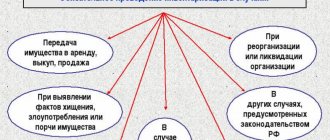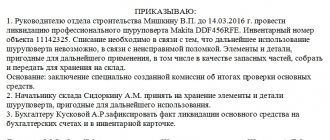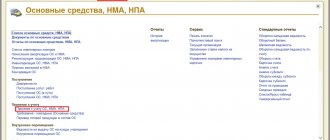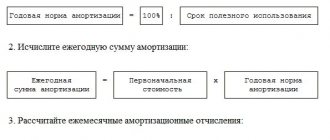Tasks of inventory of fixed assets
The frequency and sequence of inventory of fixed assets at the enterprise is enshrined in its accounting policy. It is carried out by an inventory commission specially appointed by the head of the enterprise. During this process the following goals should be achieved:
- monitoring the correctness of the preparation of primary documentation on the movement of fixed assets;
- establishing the presence of the organization’s property at the places of operation and storage, as well as its condition;
- detection of unused, missing or unaccounted for objects;
- control of the correct determination of the value of property in accounting and their reflection in the balance sheet of the organization.
Purpose and reasons for conducting an inventory of fixed assets
There are several reasons to perform such a study of warehouses and operating systems:
- it is possible to speak with certainty about the presence or absence of certain objects on the territory;
- it becomes easy to compare the actual data with those indicated in the accounting registers;
- it is allowed to correct the accounting document in accordance with the information revealed in fact.
When an inspection is carried out unscheduled, this usually happens due to discovered theft, the consequences of an emergency, or a change in management.
Nowadays it is allowed not to use strict reporting forms, but to develop your own accounting documentation. The main thing is to have all the details and positions. If you don’t have time to develop such templates, you can use standard examples in the program.
It is important that the software completely covers all tasks that arise in the enterprise. If this does not happen, then you can seek help from professionals, for example, at.
Thus, you can effectively check an enterprise’s OS using the “OS Inventory” software product.
This software allows you to use an information collection terminal with a built-in barcode reader to reconcile company fixed assets.
Each OS comes with a unique barcode label that can be printed using the driver. A standards-compliant, 100% readable barcode is automatically generated by the software based on the accession number.
The software allows you to upload information about the availability of a particular material from the 1C database, and then use the device to collect barcodes of real positions of fixed assets and balances and then load the received real information into “Inventory of fixed assets” or into “Entering balances of fixed assets and intangible assets” and for receiving availability and discrepancy reports.
The software also supports accounting by materially responsible persons (MRO) and departments.
How to register a find during re-registration?
During the recalculation of property, surpluses may be discovered that arise for the following reasons:
- fixed assets were previously written off, but are still in use;
- the fixed asset is operated without documents confirming the enterprise's ownership of it and is not listed in the accounting registers.
Such “finds” should be capitalized. This procedure can be represented as follows:
| Stages of capitalization of surplus | Contents of the procedure |
| Determining the value of discovered property | An organization can independently determine the fair value of a discovered object that is not registered. Sources of information can be information about similar funds on the balance sheet of the enterprise, press materials, etc. To establish the value, you can use the services of a professional independent assessment. When determining the price of an object, it is necessary to take into account its condition, degree of wear and tear |
| Documenting | The director of the organization issues an order to capitalize surplus property discovered during the inventory. Based on the order, it is necessary to draw up an acceptance and transfer act, form OS-1, in which, as information about the receipt of the object, it should be indicated that it was discovered during the inventory. Then fill out the fixed asset inventory card. |
Reflection of surpluses for accounting purposes
In accounting, discovered surpluses of fixed assets are classified as other income of the enterprise. Based on information about the discovered fixed assets in the inventory records, it is necessary to draw up an accounting statement that reflects the following entries:
- Dt 08 Kt 91/1 - for the cost of surpluses discovered during the inventory. The identified property can be used by the economic entity in the future in its activities;
- Dt 01 Kt 08 – a fixed asset item discovered during the inventory was put into operation.
Example. During an inventory of the enterprise's property carried out on October 15, 2021, a new monitor that was not previously taken into account was discovered. There are no primary documents for it. It has been established that the market value of a similar model is 60,000 rubles. The commission determined the useful life of the monitor to be 50 months.
The following entries should be made in accounting:
Dt 08 Kt 91/1 = 60000 – for the cost of property discovered during the inventory;
Dt 01 Kt 08 = 60000 – the detected object is put into operation;
Dt 20, 44 Kt 02 = 60000/50 = 1200 - monthly from November 2021 for the amount of accrued depreciation.
Fixed assets identified during inventory in tax accounting
The value of surplus property identified as a result of inventory is recognized as non-operating income for profit tax purposes (Clause 20, Article 250 of the Tax Code of the Russian Federation).
At the same time, the Tax Code of the Russian Federation does not contain special rules regulating the procedure for reflecting in tax accounting income from the cost of property identified as a result of an inventory. Analyzing the provisions of pp. 1 and 4 tbsp. 271, paragraph 2 of Art. 273, art. 313, art. 323 of the Tax Code of the Russian Federation, we can conclude that in tax accounting, income from property identified during the inventory is reflected on the date the property was accepted for accounting. If you have any questions, you can consult for free via chat with a lawyer at the bottom of the screen or call by phone (consultation is free), we work around the clock.
According to paragraph 1 of Art.
257 of the Tax Code of the Russian Federation, the initial cost of a fixed asset identified as a result of an inventory is defined as the amount at which such property is valued in accordance with paragraphs. 8 and 20 art. 250 Tax Code of the Russian Federation. Clause 8 of Art. 250 of the Tax Code of the Russian Federation establishes that when receiving property free of charge, the assessment of income is carried out based on market prices, determined taking into account the provisions of Art. 105.3 Tax Code of the Russian Federation. In this case, information on prices must be confirmed by the taxpayer - the recipient of the property (work, services) documented or through an independent assessment. Specialists of the Ministry of Finance of Russia also note that the assessment of the value of property identified during the inventory must be made taking into account the specified point and reflected in tax accounting in a manner similar to the procedure established for accounting purposes on the date of the inventory (letter from the Ministry of Finance of Russia dated April 22, 2011 No. 03-03-06/1/263, dated 10/12/2010 No. 03-03-06/1/644, dated 06/06/2008 No. 03-03-06/4/42). Depreciable property for profit tax purposes includes property that is owned by the taxpayer (unless otherwise provided by Chapter 25 of the Tax Code of the Russian Federation), is used by him to generate income and the cost of which is repaid by calculating depreciation. Depreciable property is property with a useful life of more than 12 months and an original cost of more than 100,000 rubles (clause 1 of Article 256 of the Tax Code of the Russian Federation). The norms of Chapter 25 of the Tax Code of the Russian Federation do not contain a prohibition on calculating depreciation of fixed assets identified as a result of inventory. Therefore, for tax accounting purposes, the organization has the right to charge depreciation on fixed assets identified during the inventory (letters of the Ministry of Finance of Russia dated 02/06/2012 No. 03-03-06/4/4, dated 12/29/2009 No. 03-03-06/1 /829, dated 03/13/2009 No. 03-03-06/1/136, dated 12/02/2008 No. 03-03-06/1/657 and others). The procedure for starting the calculation of depreciation on objects of depreciable property is established in clause 4 of Art. 259 of the Tax Code of the Russian Federation, which states that the calculation of depreciation for depreciable property items, including fixed assets, the rights to which are subject to state registration in accordance with the legislation of the Russian Federation, begins on the 1st day of the month following the month in which this facility was put into operation, regardless of the date of its state registration. Lazukova Ekaterina , expert of the Legal Consulting Service GARANT, professional accountant
The company systematically conducts an inventory of its own assets. The goal is to check the correspondence between documentary information and the actual availability of property assets owned by the company. Monitoring of fixed assets (fixed assets) is of particular importance, since this property, as a rule, is characterized by significant value and retains its properties for a long time. The article describes typical situations. To solve your problem , write to our consultant or call for free:
+7 (499) 490-27-62 – Moscow – CALL +7 – St. Petersburg – CALL
If you have any questions, you can consult for free via chat with a lawyer at the bottom of the screen or call by phone (consultation is free), we work around the clock.
+8 ext.849 – Other regions – CALL It’s fast and free! The results of the inventory may be different:
- full compliance of the real state of affairs with accounting data;
- identifying discrepancies in the form of surpluses or shortages.
Information about established surpluses/shortages for certain fixed assets is subject to mandatory reflection in the accounting system. First of all, it is necessary to consider how surplus operating systems discovered during inventory are accounted for and accounted for.
Reflection of surpluses for tax accounting purposes
In tax accounting, the opportunity to reflect property as part of fixed assets appears only if the following conditions are simultaneously met:
- the object must be the property of the enterprise;
- the fixed asset will be used to generate income;
- the service life of the property must be more than 1 year;
- the initial cost of the fixed asset should not be less than 40,000 rubles.
If an object discovered during an audit of fixed assets does not meet one of the listed conditions, then it should be taken into account as part of the inventory.
Particular attention must be paid to property valuation. The initial cost of a fixed asset is the amount of its valuation. In this case, the assessment must be documented or carried out by an independent specialist. If the valuation of the discovered property is carried out by the enterprise itself, then official sources of information on the prices of similar goods can be used as a source of data on the value.
Surpluses are recognized as non-operating income; accordingly, the value of such property is subject to taxation.
In tax accounting, compared to accounting, a difference is formed - a permanent tax liability for income tax, which is reflected: Dt 99 Kt 68.
Accounting for fixed assets discovered during inventory
If you have any questions, you can consult for free via chat with a lawyer at the bottom of the screen or call by phone (consultation is free), we work around the clock.
Clause 1 of Art. 11 of the Federal Law of December 6, 2011 No. 402-FZ “On Accounting” (hereinafter referred to as Law No. 402-FZ) determines that assets and liabilities are subject to inventory. According to paragraph 3 of Art. 11 of Law No. 402-FZ, the cases, timing and procedure for conducting an inventory, as well as the list of objects subject to inventory, are determined by the economic entity, with the exception of cases of mandatory inventory. Mandatory inventory is established by the legislation of the Russian Federation, federal and industry standards - see clause 27 of the Regulations on accounting and financial reporting in the Russian Federation, approved by Order of the Ministry of Finance of Russia dated July 29, 1998 No. 34n (hereinafter referred to as Regulation No. 34n). During the inventory, the actual presence of the relevant objects is revealed, which is compared with the data of the accounting registers (clause 2 of article 11 of Law No. 402-FZ). The procedure for conducting an inventory by organizations is established by the Methodological Guidelines for the Inventory of Property and Financial Liabilities, approved by Order of the Ministry of Finance of Russia dated June 13, 1995 No. 49 (hereinafter referred to as the Guidelines). Based on the results of the inventory, during which surpluses and (or) shortages of property are identified, comparison statements are compiled, which reflect the discrepancies between the indicators according to accounting data and the data of inventory records (clause 4.1 of the Methodological Instructions). Fixed assets, material assets, cash and other property that are in surplus are subject to capitalization and crediting, respectively, to the financial results of the organization (clause 5.1 of the Methodological Instructions). Based on clause 8, clause 16 of PBU 9/99 “Income of the Organization” (hereinafter referred to as PBU 9/99), the cost of surpluses identified during the inventory of property is reflected in other income as they are identified, that is, on the date of the inventory. When accepting property for accounting as an asset of a certain type of organization, one should be guided by the criteria (conditions) established by the relevant regulatory legal acts on accounting (letter of the Ministry of Finance of Russia dated September 8, 2009 No. 03-05-05-01/54). Thus, the procedure for accounting for fixed assets is regulated by PBU 6/01 “Accounting for fixed assets” (hereinafter referred to as PBU 6/01). By virtue of clause 4 of PBU 6/01, an asset is accounted for as a fixed asset if four conditions are simultaneously met:
- the object is intended for use in the production of products, when performing work or providing services, for the management needs of the organization, or to be provided by the organization for a fee for temporary possession and use or for temporary use;
- the object is intended to be used for a long time, i.e. a period exceeding 12 months or the normal operating cycle if it exceeds 12 months;
- the organization does not intend the subsequent resale of this object;
- the object is capable of bringing economic benefits (income) to the organization in the future.
In accordance with clause 5 of PBU 6/01, fixed assets include: buildings, structures, working and power machines and equipment, measuring and control instruments and devices, computer equipment, vehicles, tools, production and household equipment and supplies, workers, productive and breeding livestock, perennial plantings, on-farm roads and other relevant facilities.
At the same time, clause 5 of PBU 6/01 allows you to take into account fixed assets with a value within the limit established in the organization’s accounting policy, but not more than 40,000 rubles per unit, as part of inventories. If the above conditions are met, then the identified property must be taken into account on the organization’s balance sheet as part of fixed assets by debiting account 01 “Fixed assets” in correspondence with account 91 “Other income and expenses” (clause 36 of the Guidelines for accounting of fixed assets, approved by order of the Ministry of Finance of Russia dated October 13, 2003 No. 91n (hereinafter referred to as Guidelines No. 91)). If you have any questions, you can consult for free via chat with a lawyer at the bottom of the screen or call by phone (consultation is free), we work around the clock.
Paragraph 38 of Methodological Instructions No. 91 stipulates that the acceptance of fixed assets for the accounting records of an organization is carried out by an act of acceptance and transfer of fixed assets (form No. OS-1), on the basis of which an inventory card for accounting for a fixed asset object is opened for the fixed asset recorded on the balance sheet (form No. OS-6). Both forms were approved by Decree of the State Statistics Committee of the Russian Federation dated January 21, 2003 No. 7; instead, you can use independently developed forms indicating the mandatory details from Part 2 of Art. 9 of Law No. 402-FZ. Fixed assets are accepted for accounting at their original cost (clause 7 of PBU 6/01). The procedure for determining the initial cost of fixed assets identified as a result of inventory is not defined in PBU 6/01. This procedure is established by other legal acts. So, in paragraphs. “a” clause 28 of the Regulations on accounting and financial reporting in the Russian Federation, approved by order of the Ministry of Finance of the Russian Federation dated July 29, 1998 No. 34n, states that the surplus property identified as a result of the inventory is accounted for at the market value on the date of the inventory and the corresponding amount credited to the financial results of a commercial organization. A similar procedure is provided for in clause 112 of the Methodological Guidelines for Accounting for Inventories, approved by Order of the Ministry of Finance of Russia dated December 28, 2001 No. 119n. The current market value is understood as the amount of cash that can be received as a result of the sale of the specified asset on the date of acceptance for accounting. When determining the current market value, data on prices for similar fixed assets received in writing from manufacturing organizations can be used; information on the price level available from state statistics bodies, trade inspectorates, as well as in the media and specialized literature; expert opinions (for example, appraisers) on the cost of individual fixed assets (clause 29 of Guidelines No. 91).
Identification and capitalization of surpluses under the simplified tax system
Inventory is the most accessible method of accounting for property for which there is no information in accounting or documents confirming the enterprise’s ownership of it when a legal entity applies a simplified taxation system.
In order to reflect the resulting surplus in the accounts, fixed assets should be capitalized at market value based on the results of the inventory. An enterprise applying the simplified tax system has the right to conduct an assessment of the discovered object independently, taking into account information received from the media, the Internet, price lists of stores, and internal accounting information about similar fixed assets.
The discovered property should be classified as non-operating income of the organization. Further, its value will be taken into account when determining the amount of the simplified tax. In this case, it does not matter which option the company uses:
- income;
- income minus expenses.
Surpluses of a commercial enterprise are attributed to profit, and in a budgetary enterprise - to increase financing.







